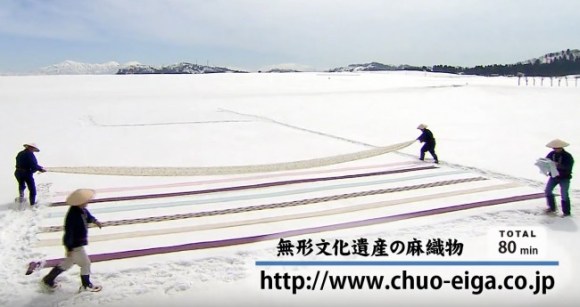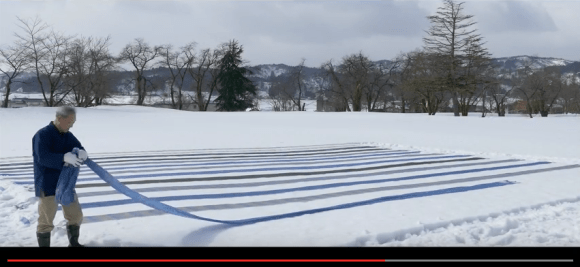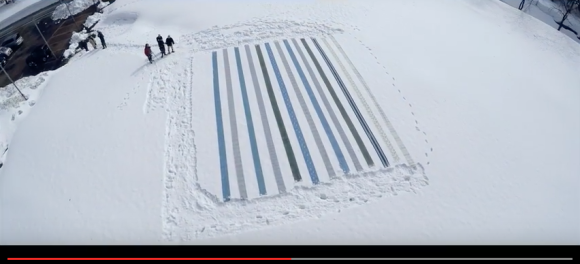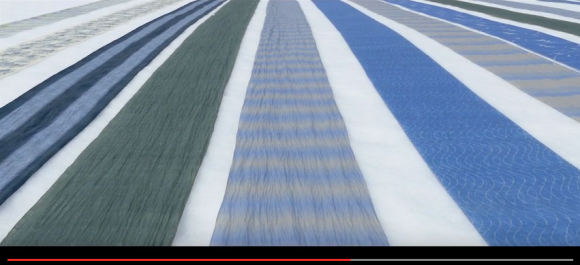
These stunning images show how craftsmen keep their UNESCO Intangible Cultural Heritage alive during the coldest months of the year.
Without snow there is no Ojiya Chijimi. It’s a fact that’s well-known in the Ojiya region of Niigata Prefecture, a place known for its wide, open fields and unusually heavy snowfall. There’s a rich cultural heritage here, and the community is dedicated to keeping it alive, especially when it comes to the local textile tradition of Ojiya Chijimi, which literally translates to “Ojiya Shrinkage”, the art of turning plant fibres into a distinct fabric with the help of sun and snow.
There are many painstaking steps involved in the traditional process, which involves hand-picking stalks of the ramie plant, extracting the fibres, fastening the threads together, and then hand weaving the fabric on a traditional ground loom. Spinning the thread tightly during the weaving process creates a distinctive crease called a “shibo”, which brings a smooth, cool feel to the fabric when worn. Once the cloth has been taken off the loom, it’s then washed in hot water and massaged with the feet. The last step in the process is to take the wet fabric outside, placing it on the snow for ten to twenty days, where it will be lightened by the elements.
The snow increases light reflection from the sun and accelerates ozone production, which helps to lighten the colours of the fabric. During this period, fields in the area look like beautiful outdoor art pieces, with long, colourful bolts of fabric standing out against the pure white snow.
While the tradition has a history which stems back to the 17th century, the fabrics made using this process are still popular today, with the light, cool material often used in summer kimono, cushion covers, and bedding. The craft is a perfect display of harmony between nature and the community, as the fabric born in winter brings its cooling touch to the locals even in the heat of the warm summer months.
To see the hand-woven fabrics being laid out in the snow, check out the captivating videos below.
We have to say, the process is as beautiful as the fashion items made with this cloth. We’re certainly glad the local cloth producers are keeping this UNESCO Intangible Cultural Heritage alive after all these centuries!
And if you love anime as well as fashion, you may be interested to see some of the high-fashion designs that inspired Sailor Moon character outfits. They haven’t been granted UNESCO status yet, but we wouldn’t be surprised if they were one day!
Source: Japaaan
Top Image: Youtube/Chuoeigasha
Screenshots: Youtube/Chuoeigasha, Youtube/PandaStudioNiigata




 The 100 Soundscapes of Japan: A list of Japan’s greatest natural, cultural, and industrial sounds
The 100 Soundscapes of Japan: A list of Japan’s greatest natural, cultural, and industrial sounds The ancient Japanese textile craft made with jagged fingernails
The ancient Japanese textile craft made with jagged fingernails Japan’s child-eating ogres prepare COVID-19 preventative measures for upcoming New Year’s Eve
Japan’s child-eating ogres prepare COVID-19 preventative measures for upcoming New Year’s Eve We test out Uniqlo’s “new and improved” Airism mask for form, fashion, and function
We test out Uniqlo’s “new and improved” Airism mask for form, fashion, and function Preserve a piece of Japanese culture during Corona with your own mini shrine hand-washing ladle
Preserve a piece of Japanese culture during Corona with your own mini shrine hand-washing ladle McDonald’s new Happy Meals offer up cute and practical Sanrio lifestyle goods
McDonald’s new Happy Meals offer up cute and practical Sanrio lifestyle goods All-you-can-drink Starbucks and amazing views part of Tokyo’s new 170 meter-high sky lounge
All-you-can-drink Starbucks and amazing views part of Tokyo’s new 170 meter-high sky lounge Studio Ghibli glasses cases let anime characters keep an eye on your spectacles
Studio Ghibli glasses cases let anime characters keep an eye on your spectacles More foreign tourists than ever before in history visited Japan last month
More foreign tourists than ever before in history visited Japan last month Beautiful Sailor Moon manhole cover coasters being given out for free by Tokyo tourist center
Beautiful Sailor Moon manhole cover coasters being given out for free by Tokyo tourist center Hamster abandoned at Tokyo ramen restaurant gets new home
Hamster abandoned at Tokyo ramen restaurant gets new home Arrest proves a common Japanese saying about apologies and police
Arrest proves a common Japanese saying about apologies and police Starbucks reopens at Shibuya Scramble Crossing with new look and design concept
Starbucks reopens at Shibuya Scramble Crossing with new look and design concept Is the new Shinkansen Train Desk ticket worth it?
Is the new Shinkansen Train Desk ticket worth it? Tokyo’s most famous arcade announces price increase, fans don’t seem to mind at all
Tokyo’s most famous arcade announces price increase, fans don’t seem to mind at all Disney princesses get official manga makeovers for Manga Princess Cafe opening in Tokyo
Disney princesses get official manga makeovers for Manga Princess Cafe opening in Tokyo Beautiful new Final Fantasy T-shirt collection on the way from Uniqlo【Photos】
Beautiful new Final Fantasy T-shirt collection on the way from Uniqlo【Photos】 Foreign English teachers in Japan pick their favorite Japanese-language phrases【Survey】
Foreign English teachers in Japan pick their favorite Japanese-language phrases【Survey】 Japanese convenience store packs a whole bento into an onigiri rice ball
Japanese convenience store packs a whole bento into an onigiri rice ball We try out “Chan Ramen”, an underground type of ramen popular in the ramen community
We try out “Chan Ramen”, an underground type of ramen popular in the ramen community Studio Ghibli releases Kiki’s Delivery Service chocolate cake pouches in Japan
Studio Ghibli releases Kiki’s Delivery Service chocolate cake pouches in Japan Japan’s bone-breaking and record-breaking roller coaster is permanently shutting down
Japan’s bone-breaking and record-breaking roller coaster is permanently shutting down New definition of “Japanese whiskey” goes into effect to prevent fakes from fooling overseas buyers
New definition of “Japanese whiskey” goes into effect to prevent fakes from fooling overseas buyers Our Japanese reporter visits Costco in the U.S., finds super American and very Japanese things
Our Japanese reporter visits Costco in the U.S., finds super American and very Japanese things Studio Ghibli unveils Mother’s Day gift set that captures the love in My Neighbour Totoro
Studio Ghibli unveils Mother’s Day gift set that captures the love in My Neighbour Totoro Foreign passenger shoves conductor on one of the last full runs for Japan’s Thunderbird train
Foreign passenger shoves conductor on one of the last full runs for Japan’s Thunderbird train Domino’s Japan now sells…pizza ears?
Domino’s Japan now sells…pizza ears? New Japanese KitKat flavour stars Sanrio characters, including Hello Kitty
New Japanese KitKat flavour stars Sanrio characters, including Hello Kitty Kyoto creates new for-tourist buses to address overtourism with higher prices, faster rides
Kyoto creates new for-tourist buses to address overtourism with higher prices, faster rides Sales of Japan’s most convenient train ticket/shopping payment cards suspended indefinitely
Sales of Japan’s most convenient train ticket/shopping payment cards suspended indefinitely Sold-out Studio Ghibli desktop humidifiers are back so Totoro can help you through the dry season
Sold-out Studio Ghibli desktop humidifiers are back so Totoro can help you through the dry season Japanese government to make first change to romanization spelling rules since the 1950s
Japanese government to make first change to romanization spelling rules since the 1950s Ghibli founders Toshio Suzuki and Hayao Miyazaki contribute to Japanese whisky Totoro label design
Ghibli founders Toshio Suzuki and Hayao Miyazaki contribute to Japanese whisky Totoro label design Doraemon found buried at sea as scene from 1993 anime becomes real life【Photos】
Doraemon found buried at sea as scene from 1993 anime becomes real life【Photos】 Tokyo’s most famous Starbucks is closed
Tokyo’s most famous Starbucks is closed One Piece characters’ nationalities revealed, but fans have mixed opinions
One Piece characters’ nationalities revealed, but fans have mixed opinions We asked a Uniqlo employee what four things we should buy and their suggestions didn’t disappoint
We asked a Uniqlo employee what four things we should buy and their suggestions didn’t disappoint Princesses, fruits, and blacksmiths: Study reveals the 30 most unusual family names in Japan
Princesses, fruits, and blacksmiths: Study reveals the 30 most unusual family names in Japan Japan petitions to add 40 traditional folk dances to UNESCO’s Intangible Cultural Heritage list
Japan petitions to add 40 traditional folk dances to UNESCO’s Intangible Cultural Heritage list Traditional Japanese washi paper features Totoro and friends in 20 beautiful seasonal scenes
Traditional Japanese washi paper features Totoro and friends in 20 beautiful seasonal scenes Neo Kimono releases innovatively traditional heel covers made from artisanal fabric
Neo Kimono releases innovatively traditional heel covers made from artisanal fabric Peace Kitchen: promoting Japanese food (and maybe something more) across the world
Peace Kitchen: promoting Japanese food (and maybe something more) across the world Gorgeous drinking bottles using kimono fabric now available with new designs and we want them all
Gorgeous drinking bottles using kimono fabric now available with new designs and we want them all Japanese bonsai trees made from paper stay beautiful without water or pruning
Japanese bonsai trees made from paper stay beautiful without water or pruning Laser-cut, 360-degree “book” lets you bring Mt. Fuji into your home
Laser-cut, 360-degree “book” lets you bring Mt. Fuji into your home Walk the streets of Japan in style with bushido-influenced men’s summer kimono range from Kyoto
Walk the streets of Japan in style with bushido-influenced men’s summer kimono range from Kyoto Kyoto kimono fabric Sailor Moon wallet would look as good in Japan’s old capital or Crystal Tokyo
Kyoto kimono fabric Sailor Moon wallet would look as good in Japan’s old capital or Crystal Tokyo Zippered pouches made from candy bags are the latest creative DIY craze on Twitter
Zippered pouches made from candy bags are the latest creative DIY craze on Twitter Cheap cosplay: How to make an awesome magic sword slash for just three bucks【Photos】
Cheap cosplay: How to make an awesome magic sword slash for just three bucks【Photos】 Japanese company creates lacquered tableware that feels like human skin
Japanese company creates lacquered tableware that feels like human skin The top 10 instances when Japanese people feel thankful to be Japanese
The top 10 instances when Japanese people feel thankful to be Japanese Art Aquarium Ginza offers a captivating new way to enjoy the cherry blossoms–with goldfish!
Art Aquarium Ginza offers a captivating new way to enjoy the cherry blossoms–with goldfish! Japanese city offering authentic handcrafted swords in exchange for “tax” payments
Japanese city offering authentic handcrafted swords in exchange for “tax” payments First-of-its-kind towel is totally worth its 5,000 yen price, customers say
First-of-its-kind towel is totally worth its 5,000 yen price, customers say
Leave a Reply